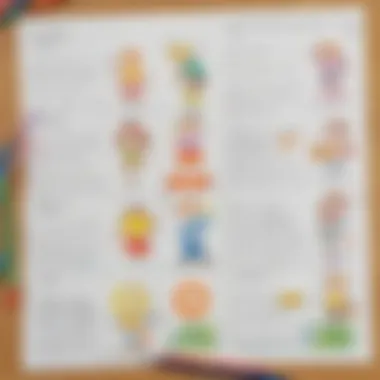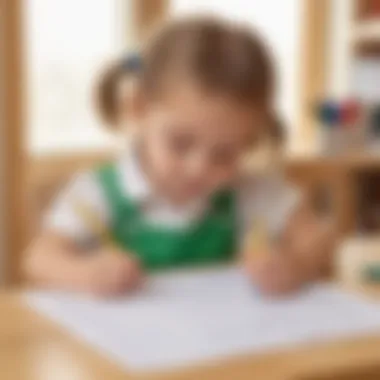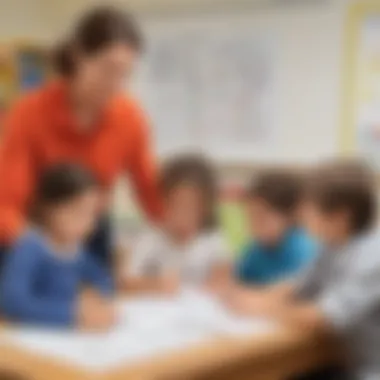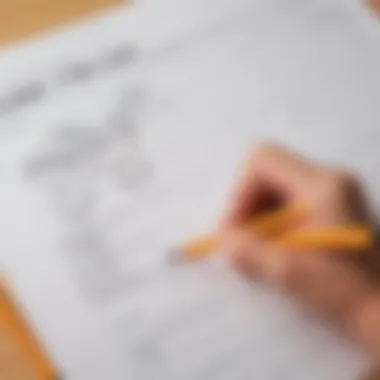Engaging Tracing Sentences Worksheets for Kindergarten


Intro
Tracing sentences worksheets are a valuable resource for kindergarten students. They play a vital role in enhancing fine motor skills and literacy development. In a world where technology increasingly dominates, the basics of writing remain crucial. As children grasp how to form letters and construct sentences, they build the foundations of communication. Worksheets designed for tracing sentences target specific abilities that help children learn to write effectively. They engage children while enriching their early educational experience. This article will delve into these worksheets' significance, usage, and creative nurturing potential.
Creative Activities
Engaging in creative activities is essential for reinforcing what children learn through tracing worksheets. Such activities stimulate not just fine motor skills but also creativity. Here are some ideas.
Craft Ideas
- Sentence Building with Cutouts: Children can cut out letters and arrange them on a canvas to form sentences. This activity reinforces letter recognition and proper sequencing.
- Coloring Sentences: Provide children with worksheets that have sentences that need to be decorated or colored. This adds a personal touch and encourages engagement.
- Sticker Sentences: Using stickers to represent words allows kids to stick them in the right order to complete a sentence. This playful interaction combines learning with fun.
Step-by-Step Guides
- Cutout Activity: Prepare cutouts for each letter and sentence structure at home. Help your child arrange these pieces into sentences. Monitor the activity to provide guidance.
- Coloring Sessions: Print simple traces of sentences. Let children choose their colors to personalize the sentences. Encourage discussions on the sentence meaning as they color.
- Sticker Placement: Get some basic stickers related to the sentences. Have children place these to visualize the meaning better. Support them through the process by asking questions about the sentences.
Educational Value
Participating in structured activities enhances understanding and retention of written communication. The creativity encouraged in these activities contributes significantly to children's literacy, even as they enhance fine motor skill development.
Closure
Tracing sentences worksheets provide an intersection of education and creativity. By utilizing them alongside engaging activities, parents and educators set the stage for effective learning. Recognizing the vital role of these small yet meaningful exercises in a child’s educational journey ensures that principles of literacy become ingrained early on. For more insights, you might want to look deeper into resources like Encyclopaedia Britannica or informative discussions on Reddit.
The Importance of Handwriting in Early Education
Handwriting skills are critical foundations in a child’s early education. As preschool and kindergarten students learn to write, they do more than just form letters. They engage in an intricate process that aids in overall cognitive development. Moreover, tracing sentences worksheets act as effective tools for honing writing techniques and improving literacy. Several aspects underscore why handwriting is important at this stage in a child's educational journey.
Cognitive Development and Writing Skills
Cognitive development during the early years is pivotal. When children practice handwriting, they not only memorize shapes but also enhance their problem-solving abilities. This process involves recognizing letters, sounding them out, and constructing words. As they trace sentences, they begin connecting sounds to symbols. Children become more aware of language mechanics, encouraging reading skills as well.
Additionally, writing is a form of expression. Tracing sentences helps children articulate ideas. This builds confidence and lays groundwork for more complex writing tasks in the future. Improving cognitive skills through tracing may also positively impact academic performance across subjects beyond language arts.
Motor Skills Enhancement
The act of writing by hand significantly contributes to motor skill improvement, particularly fine motor skills. Tracing worksheets put emphasis on grip and control of writing instruments like pencils or markers. Early exposure to writing supports hand strength and dexterity. When kindergarteners trace letters and sentences, they engage different muscles in their hands and fingers.
This repeated practice enhances hand-eye coordination as well. Children learn to coordinate movements while following the lines and curves of letters. Such skills are foundational not only for writing but also for various daily tasks. Mastery of fine motor skills is essential, especially as students progress through their education, where handwriting often remains a necessary form of communication.
“Handwriting is not just a skill, it's a bridge to creativity and structure.”
Children derive satisfaction from mastering letter formations and improved control over their writing implements. Ultimately, fostering strong motor skills during these early years sets a strong precedent for future academic success.
What Are Tracing Sentences Worksheets?
Tracing sentences worksheets are tools designed to help kindergarten students develop essential writing skills. They serve a precise purpose in early education. Through tracing, children get the chance to practice forming letters, understanding word patterns, and improving their penmanship. The worksheets cater to different learning styles. As children finger-trace, listen, and repeat, they engage multiple senses which enhances their grasp of language structure and writing techniques.
Greater emphasis on tracing fosters a strong foundation. This prepares students for more complex writing tasks in their academic journey. The techniques employed in these worksheets align with key developmental milestones for young learners.


Definition and Purpose
Tracing sentences worksheets consist of outlines of letters and words that children trace over. The main goal is to provide the children a structured writing environment. They reinforce the correct formation of letters into recognizable words. The benefits extend from cognitive processes to fine motor development. These are more than simple worksheets; they bolster confidence in the writing abilities of young experts in the making.
Most importantly, tracing encourages learners to focus on the correct order and formation of letters. This explicit guidance helps mitigate common issues with letter confusion or reversals. The outcome is a more confident writer; connecting thoughts on the paper effectively.
Types of Tracing Sentences Worksheets
Various forms of tracing sentences worksheets exist to increase engagement and meet diverse educational objectives. Some worksheets include common sentence structures—habits of writing foundational sentences help students build their literacy.
- Simple Tracing Worksheets: Here, children get to trace easily understood words, often simple nouns or everyday verbs. This ensures that the tracing instructions are not overwhelming.
- Sentence Construction Worksheets:
These focus on familiar phrases or sentences. Young writers have an opportunity to construct sentences. They foster cognitive growth, vocabulary expansion, and a tailored challenge. - Thematic Worksheets:
These relate to specific subjects or seasons. Worksheets on themes such as animals, holidays or weather can ignite a child’s imagination.
The careful selection of different types of tracing sentences worksheets means enabling teachers and parents to target varied skill levels within their students effectively.
Benefits of Tracing Sentences Worksheets
Tracing sentences worksheets play an important role in the early literacy development of kindergarten students. These worksheets serve as key tools that help strengthen essential writing skills, promote language development, and cultivate an appreciation for writing. By focusing on specific areas of literacy ang fine motor skill enhancement, educators and parents can utilize these worksheets to foster a supportive and engaging learning environment.
Improving Letter Formation
One of the primary benefits of tracing sentences worksheets lies in improving letter formation. When young learners trace letters and words, they practice the motions of handwriting. This process, done repetitively, helps reinforce the correct shapes and sizes of each letter. It contributes to muscle memory so that over time, students are able to write letters independently more consistently.
Proper letter formation makes written communication easier to read. Moreover, when kids recognize their letters and develop a personal style, their confidence grows. In addition, careful attention to spacing—between letters, words and sentences—is cultivated. This aspect is critical for maintaining clarity in their writing as they progress through their educational journey.
Building Vocabulary and Language Skills
Tracing sentences worksheets can enhance vocabulary and overall language skills. As children trace pre-written sentences, they receive constant exposure to new words and language structures. They start to learn how words fit together and form meaningful expressions. This sharing of knowledge enables them to understand how sentences are constructed.
Fostering vocabulary acquisition can have staggering effects on children's communication skills. When they know more words, they can express more complex ideas. A well-rounded vocabulary also assists in reading comprehension later on. As students begin to read more at an early age, enhanced vocabulary plays a larger role in academic success. Activities like this ground students, inviting interaction with their surroundings while boosting verbal capabilities in a methodical fashion.
Encouraging Writing Fluency
Writing fluency represents the ability to write with speed and ease. Tracing sentences worksheets solidly contribute to this fluency through practice. By repeating the tracing, students gain confidence in their writing abilities. They also reduce their frustrations associated with forming letters since these materials provide structured writing practice.
When students have ample exposure to writing via tracing, it becomes more automatic over time. Writing then transforms from a laborious result to a practiced skill. As a result, youngsters have the newly acquired ability to focus more on the content rather than the mechanics of writing. This fluidity supports their overall educational journey.
“Fluency is like a bridge; as learners become more fluent, they can take bigger initiatives in their writing and communication.”
Ultimately, the magic of tracing sentences worksheets lies in their myriad benefits for young learners. Improved letter formation leads intuitively into a more robust vocabulary and language usage, establishing a firm foundation for blossoming writers that stretches beyond the classroom. Introducing these worksheets effectively can mark significant strides in literacy and fluency during this pivotal stage of education.
Incorporating Worksheets into Learning
Incorporating tracing sentences worksheets into the learning process for kindergarten children is essential. Effective use of these worksheets enhances skills that are foundational for literacy. They encourage structured practice that intertwines fun with learning. When educators and parents strategically include such worksheets, it addresses the various learning styles present in classrooms. Various educational theories highlight the importance of combining instruction with engagement. This balancing act fosters both comprehension and retention in young learners.
Classroom Strategies
To maximize the benefits of tracing worksheets, teachers should adopt structured classroom strategies. Here are several approaches:
- Daily Practice Sessions: Integrating short, consistent daily practice with tracing worksheets can solidify fine motor skills. Five to ten minutes each day goes a long way.
- Group Activities: Encourage collaboration by assigning group tracing tasks. This not only reinforces skills but also builds social interactions.
- Interactive Display: Display student work around the classroom. This honors their efforts and motivates peer learning. Students feel pride seeing their own handiwork.
- Feedback Loops: Provide immediate and constructive feedback as students work. Recognizing achievements promotes further engagement and increases confidence.
At-Home Activities


Parental involvement is pivotal in reinforcing skills learned in school. At-home activities should complement what children practice in the classroom. The following methods can be useful:
- Tracing Alphabet Books: Invest in or create books with outlines for children to trace letters and sentences. This can be a rainy day activity that also entertains.
- Daily Writing Prompts: Provide simple sentences or quotes that children can trace or copy. Doing this reinforces new vocabulary learned in class.
- Utilizing Everyday Items: Engage with active writing across various mediums. Parents can use anything from tablet apps to crayons on large sheets of paper.
- Regular Check-Ins: Parents should take time to review their children's progress. Discuss successes and areas to improve, ensuring exercises remain enjoyable and pressure-free.
Integrating worksheets into both classroom and home settings nurtures and enhances writing skills while fostering a strong learning environment.
Creating Effective Tracing Worksheets
Creating effective tracing worksheets is an essential aspect of supporting kindergarten students in their handwriting journey. These worksheets serve as foundational tools that not only guide young learners through the process of letter formation but also play a significant role in nurturing fine motor skills and enhancing cognitive development. When designed correctly, tracing worksheets offer students approved ways to practice writing sentences, building their confidence in letters and words.
Components of a Good Worksheet
A good tracing worksheet contains several vital components that work together to facilitate learning. These elements are purposeful, ensuring that the child engages positively with the content.
- Clear Instructions: The worksheet should begin with straightforward guidelines that allow kids to understand the goal of the exercise without any confusion.
- Visual Support: Integrating pictures or icons related to the sentences can inspire children. Illustrate the topics or words they will be writing.
- Line Options: Different line types should be used for the letters. Solid lines work for beginners, while dotted or dashed lines could provide incremental challenges as children's skills develop.
- Adequate Space: There must be enough room for tracing and writing. This space allows children to gain confidence as they improve their letter sizes and spacing.
- Engaging Themes: Design worksheets around themes relevant to childhood, such as animals, nature, or community jobs. This adds an element of interest, drawing students into the learning experience.
The design of tracing worksheets should prioritize clarity and engagement, providing children with fun and effective practice opportunities.
Assessing Student Progress
Assessing student progress in handwriting is essential for monitoring growth and ensuring competency in skills. Particularly for young learners in kindergarten, these assessments shed light on their development of fine motor abilities and written expression. As educators and parents use tracing sentences worksheets, systematically reviewing a child’s work allows for focused learning experiences, addressing both strengths and weaknesses with precision.
Methods of Assessment
One effective approach for assessing student progress when using tracing sentences worksheets is through direct observation. Teachers should look for fluidity in movements as a child traces letters, noting posture, pencil grip, and overall engagement. This firsthand insight reveals much about the child’s confidence and comfort level.
Additionally, portfolio assessments can be beneficial. In this method, specific samples of a child's work are collected over time, including early efforts and more recent achievements. This collection demonstrates a progression in skill level, providing concrete evidence that supports a child’s growth journey. Combing through the portfolio can highlight improvements in letter clarity, sentence structure, and creativity.
Some educators and parents might consider informal assessments as well. Scheduling short, one-on-one sessions allows educators to observe individual learning styles closely. Questions about the completed worksheets can provide insight into a child’s understanding of writing concepts and vocabulary.
Identifying Areas for Improvement
Recognizing areas for improvement is a pivotal part of the assessment procedure. It is essential to differentiate between mistakes that are typical in early writing and those that indicate need for further instruction. A consistent review can uncover patterns that suggest specific skill deficits, such as persistent difficulty with certain letters or repeated misunderstandings of formatting.
Another useful metric is consistency across worksheets. For instance, if a student struggles more with lowercase letters compared to uppercase, targeted practice can be introduced. Additionally, being aware of children’s emotional responses during assignments highlights whether frustration or disengagement is present, signifying the need adapting strategies.
Collecting feedback from children themselves can also provide context. Gaining informal insights into what they find challenging or enjoyable can both inform teaching methodology and reinforce their motivation to improve.
Tracking student progress is not merely an evaluative task. It is a rich ecosystem of growth, nourishment of creativity, and development of precise coordination between mind and hand. With the right tools, such as tracing sentences worksheets inching away from assessment establishing ways to fine-tune educational development enhances success in crucial early learning stages.
Consistent assessment aids in understanding children's writing journeys, ensuring that they thrive both academically and personally.
Digital vs.
Paper Tracing Worksheets
The discussion about digital versus paper tracing worksheets is important when we think about methods of learning for kindergarten students. Both options have unique benefits, and understanding these can help parents and educators improve writing engagement and skill development for early learners.
Advantages of Digital Tools
Digital tools bring a modern twist to the learning process. With tablets, computers, and smart devices, students can trace sentences using software geared towards young learners. Some advantages of these digital tools include:


- Interactive features: Many apps offer sounds and animations that catch children's attention and create a playful environment for learning.
- Instant feedback: Children receive immediate responses to their tracing, helping them grasp their mistakes and correct them right away.
- Portability: Digital worksheets can be used anywhere, making it easy for learning to occur in various settings, not limited to a classroom.
On the other hand, schools with limited resources can consider affordable apps. These could lower costs while providing a progressive and enjoyable platform for students.
Benefits of Traditional Worksheets
Traditional paper worksheets, however, endure as a beloved method of learning. They come with various benefits that support handwriting practice and fine motor development. Here are key benefits observed:
- Tactile experience: The tactile feedback of holding a pencil on paper brings a sense of traditional learning. This can enhance muscle memory, crucial for solidifying proper handwriting skills.
- No distractions: Unlike digital devices, paper can avoid interruptions from notifications or other applications. This helps students focus directly on the task at hand.
- Checkmarks and creativity: Many children enjoy using crayons or colored pencils to personalize their worksheets. This can occur with their every marking, fostering engagement.
Both formats have distinct roles in developing writers. The choice often hinges on personal preference and available technology.
The right approach can mix both digital and traditional methods for a comprehensive skill development strategy.
Choosing the best format depends on what resonates most with each child's learning style. Ultimately, encouraging children through appropriate worksheets only brightens the path towards proficient writing skills.
Future of Handwriting Education
The role of handwriting in education is changing. It has been central to communication and learning for centuries. Today, there is a renewed focus on the importance of handwriting, especially in early education like kindergarten. The future of handwriting education emphasizes not only the technique of writing but also its purpose in the digital age. Effective educational practices aim to cultivate children's learning experiences.
Emerging Trends in Education
Educators are observing new trends influencing handwriting education. The use of interactive learning materials is growing. Schools are implementing tools that like games and online applications help children feel connected and engaged while learning to write. This shift towards incorporating creativity is important to sustain interest in handwriting.
Key movements in education include:
- Multi-sensory learning approaches: These techniques focus on all aspects of learning by sight, sound, and movement, making handwriting practice more natural right from the start.
- Integration with core subjects: Schools incorporate writing with literacy skills along with other subjects. By linking handwriting to storytelling or subjects like science, children better understand its relevance.
The inclusion of such dynamic and varied techniques are creating a context where handwriting becomes more than a task. It establishes itself as an integral skill interwoven into a broader learning narrative.
The Role of Technology
While pen and paper are still vary influential in handwriting education, technology's role is more prominent than ever. Tablets and apps targeting handwriting, such as LetterSchool and Writing Wizard, engage children with interactive features. These tools adapt to stages of learning and respond to individual needs, enhancing both interest and retention.
Benefits of technology in handwriting education:
- Personalized learning experiences: Digital platforms often let students learn at their own pace. Adjustments can be made quickly based on their performance.
- Immediate feedback: Online worksheets provide quick assessments, allowing children to see their progress and can motivates them to improve CRטיםannotations and markings.
- Access to resources: Platforms like en.wikipedia.org and britannica.com offer comprehensive content covering various topics, which helps create broader and enriching writing assignments.
Ultimately, as input from educators becomes more integrated with technology, the traditional sense of handwriting is evolving. Notably, handwriting remains relevant; it embraces innovation and adapts as educational needs progress.
Resources for Educators and Parents
The focus of this section centers on the importance of providing valuable resources for teachers and parents enhancing the use of tracing sentences worksheets. Educators and guardians play a critical role in a child's literacy journey. Therefore, accessible tools and well-structured resources become essential to effectively raise a child's interest and abilities in handwriting. Having trusted resources can also help streamline teaching methods and homework support. They enable young learners to receive consistent guidance, resulting in improvement in both accuracy and confidence in writing.
Recommended Websites and Tools
Educators and parents can discover numerous websites and tools designed to assist with tracing sentences worksheets. A selection of effective resources include:
- Education.com: This site derived provides several worksheets covering various writing styles, including tracing sentences tailored for kindergarten.
- Teachers Pay Teachers: This platform allows teachers to share and purchase original teaching materials, fostering creativity and resource diversity. It has many worksheet styles available.
- Scholastic: Known for its educational products, Scholastic offers a variety of printable worksheets, engaging activities, and resources to support literacy efforts.
Utilizing these sites allows for personalized lesson plans and promotes an interactive approach to writing practice. Guidance provided from these websites can help enhance children's learning experience.
Books and Publications
Exitent literary supports like books and publications can enrich understanding of handwriting practices and aid those involved in teaching young children. Some recommendated titles for deeper engagement include:
- **







